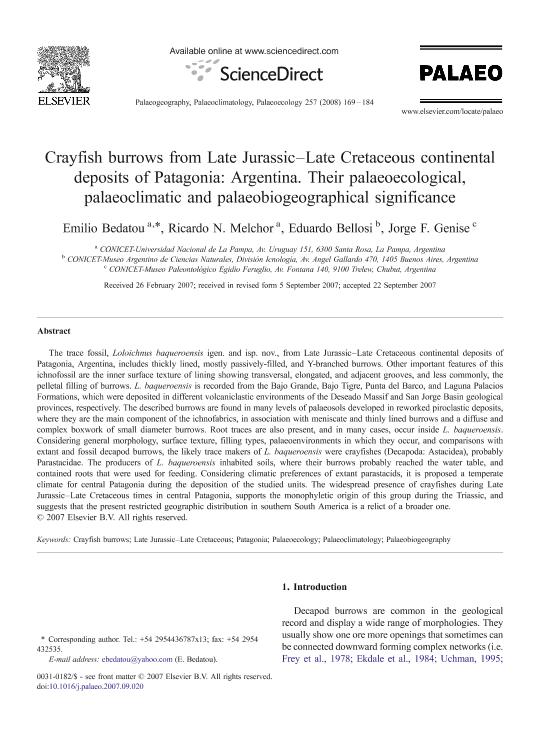Artículo
Crayfish burrows from Late Jurassic-Late Cretaceous continental deposits of Patagonia: Argentina. Their palaeoecological, palaeoclimatic and palaeobiogeographical significance
Fecha de publicación:
01/2008
Editorial:
Elsevier Science
Revista:
Palaeogeography, Palaeoclimatology, Palaeoecology
ISSN:
0031-0182
Idioma:
Inglés
Tipo de recurso:
Artículo publicado
Clasificación temática:
Resumen
The trace fossil, Loloichnus baqueroensis igen. and isp. nov., from Late Jurassic-Late Cretaceous continental deposits of Patagonia, Argentina, includes thickly lined, mostly passively-filled, and Y-branched burrows. Other important features of this ichnofossil are the inner surface texture of lining showing transversal, elongated, and adjacent grooves, and less commonly, the pelletal filling of burrows. L. baqueroensis is recorded from the Bajo Grande, Bajo Tigre, Punta del Barco, and Laguna Palacios Formations, which were deposited in different volcaniclastic environments of the Deseado Massif and San Jorge Basin geological provinces, respectively. The described burrows are found in many levels of palaeosols developed in reworked piroclastic deposits, where they are the main component of the ichnofabrics, in association with meniscate and thinly lined burrows and a diffuse and complex boxwork of small diameter burrows. Root traces are also present, and in many cases, occur inside L. baqueroensis. Considering general morphology, surface texture, filling types, palaeoenvironments in which they occur, and comparisons with extant and fossil decapod burrows, the likely trace makers of L. baqueroensis were crayfishes (Decapoda: Astacidea), probably Parastacidae. The producers of L. baqueroensis inhabited soils, where their burrows probably reached the water table, and contained roots that were used for feeding. Considering climatic preferences of extant parastacids, it is proposed a temperate climate for central Patagonia during the deposition of the studied units. The widespread presence of crayfishes during Late Jurassic-Late Cretaceous times in central Patagonia, supports the monophyletic origin of this group during the Triassic, and suggests that the present restricted geographic distribution in southern South America is a relict of a broader one.
Archivos asociados
Licencia
Identificadores
Colecciones
Articulos(CCT-CENPAT)
Articulos de CTRO.CIENTIFICO TECNOL.CONICET - CENPAT
Articulos de CTRO.CIENTIFICO TECNOL.CONICET - CENPAT
Articulos(INCITAP)
Articulos de INST.D/CS D/L/TIERRA Y AMBIENTALES D/L/PAMPA
Articulos de INST.D/CS D/L/TIERRA Y AMBIENTALES D/L/PAMPA
Citación
Bedatou, Emilio; Melchor, Ricardo Nestor; Bellosi, Eduardo Sergio; Genise, Jorge Fernando; Crayfish burrows from Late Jurassic-Late Cretaceous continental deposits of Patagonia: Argentina. Their palaeoecological, palaeoclimatic and palaeobiogeographical significance; Elsevier Science; Palaeogeography, Palaeoclimatology, Palaeoecology; 257; 1-2; 1-2008; 169-184
Compartir
Altmétricas




